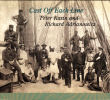List of Songs
NOTHIN' BUT A HUMBUG
Lead: Richard

| Back to List of Songs |
NOTHIN' BUT A HUMBUGLead: Richard |
 |
Collected by Professor James M. Carpenter from Welsh singer Rees Baldwyn who learned it from singers in Savannah and New Orleans.
LYRICS:
Well, a catfish grow on a huckleberry vine
Chorus: So they say, so they say
Catfish grow on a huckleberry vine
Chorus: And that's all I know – I said
Full Chorus:
You're nothin' but a humbug
So they say, so they say
Well you're nothin' by a humbug
And that's all I know
Well Dandy Jim from North Carolina
He's come home for to marry Dinah
Well I never seen the like since I been born
Sailor on the fife-rail crackin' out corn
One day the blackbird said to the crow
Why do you love your farmer so
Well that's my trade since Adam was born
Scratchin' and a-diggin' up farmers' corn
Said the blackbird to the crow
Don't tell those pretty gals all you know
Well high and dry, we'll hoist her high
Hoist her high for a bulgine pie
Chorus twice at end
I fell in love with this song after hearing it sung at one of the late night singing sessions at Mystic Seaport in 2005. The singer hadn't recorded the song but he told me Bob Walser recorded it on his album When Our Ship Comes Home – an album I had just purchased while at the festival.
The song comes from the James M. Carpenter collection. James Madison Carpenter (1888-1984) was a Harvard-trained scholar who undertook folksong, and later folk play, collecting in Britain from 1928-1935. His extensive and important collection, now held at the Library of Congress, was never published and Carpenter remained a relatively unknown figure in Anglo-American folksong scholarship.
Bob Walser wrote the article 'Here We Come Home In A Leaky Ship!': The Shanty Collection of James Madison Carpenter that appears in the Folk Music Journal, 1988, Volume 7, Number 4, a Special Issue on the James Madison Carpenter Collection. Nothin' But A Humbug was collected from Welsh singer Rees Baldwyn. Carpenter notes that "Mr. Baldwyn learned this from the Negro singers in Savannah and New Orleans. The words 'Dandy Jim from North Carolina' are echoes from a minstrel song of about 65 or 70 years ago. It is sung with much emphasis and force."
Walser says, in his article, "according to Carpenter, two 'Negro pile drivers of the southern ports' used this song to coordinate their rhythm as they alternately struck the same pile with two sledges. The simple words, as well as the straightforward alternation of the two parts, suggested the song could have been used at sea for halyard work. The application was tested by attempting to use the song at halyards aboard the full-rigged ship Joseph Conrad at Mystic Seaport where sail-setting demonstrations are performed daily during the summer months. In that context it was found that the short verses ending with rests left a relatively long moment without metrical information before the chorus, making it difficult for the chorus to enter together. How, then, did Rees Baldwin maintain this song in his repertoire? Did he simply remember it after hearing the pile drivers sing it, perhaps only one time, or did he use it at sea for some task other than halyards? As Hugill wrote, 'in talking about shanties and shantying one cannot be too dogmatic'. Perhaps Baldwyn found his own particular use for this song and thus preserved it in memory until Carpenter, in his turn, could preserve it in sound and manuscript."